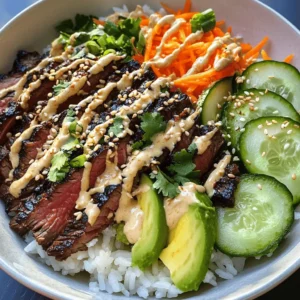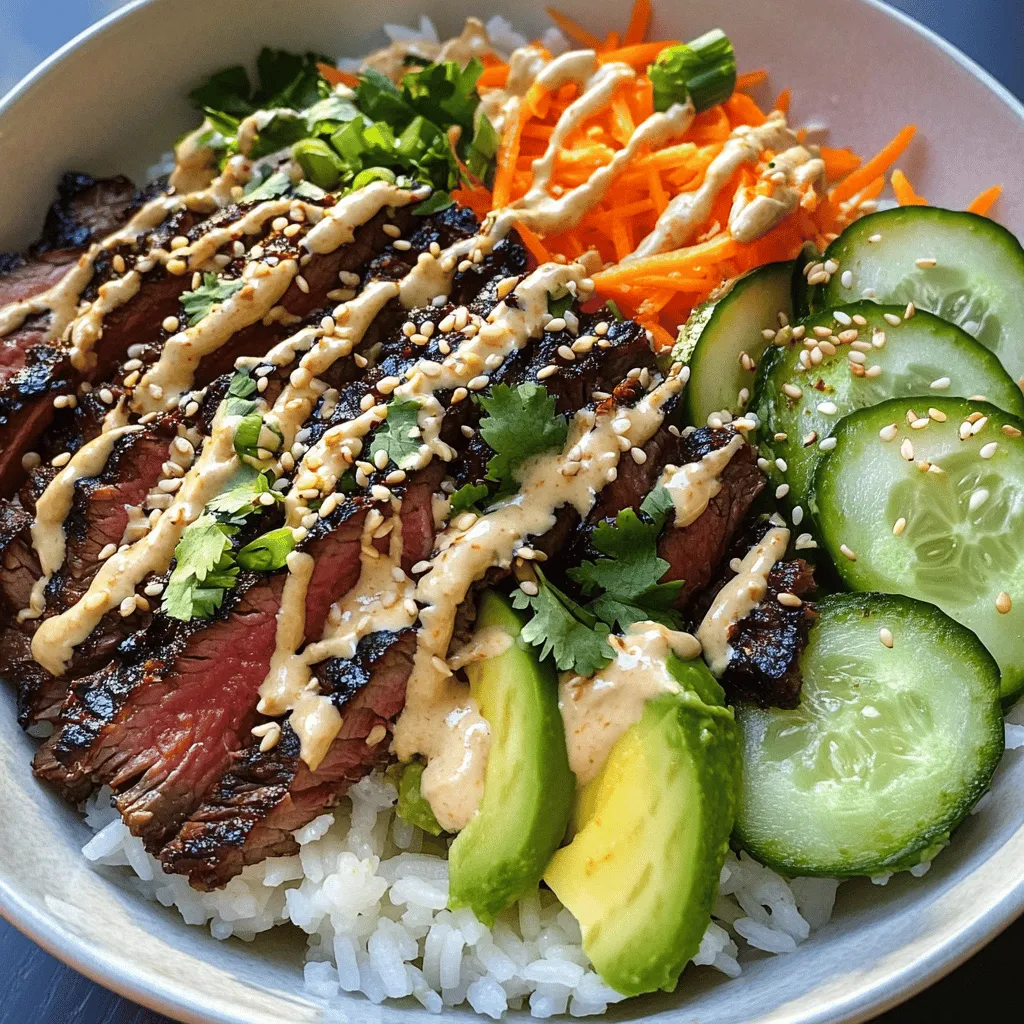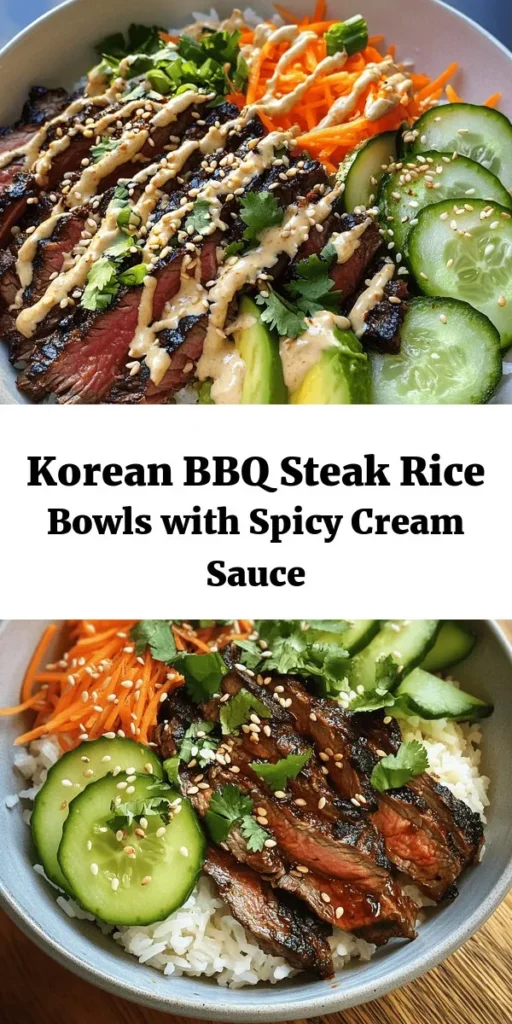Introduction to Korean BBQ Steak Rice Bowls
Delve into the vibrant world of Korean cuisine with this delightful recipe for Korean BBQ Steak Rice Bowls with Spicy Cream Sauce. This dish is a wonderful representation of the bold flavors and fresh ingredients that characterize Korean cooking. It combines marinated flank steak, an array of colorful vegetables, and a creamy, spicy sauce that ties everything together beautifully. The result is a harmonious blend of flavors and textures that will excite your palate and satisfy your hunger.
Korean BBQ has gained immense popularity around the globe, and for good reason. The grilling technique, combined with a variety of marinades and sauces, creates a unique dining experience that is both interactive and delicious. These rice bowls are perfect for any occasion, whether you’re hosting a dinner party or simply craving a comforting meal at home. Not only are they delicious, but they are also visually appealing, making them a feast for the eyes as well as the taste buds.
In this article, we’ll explore the intricacies of preparing these mouthwatering rice bowls, from marinating the steak to assembling the perfect bowl. By the end, you will have all the knowledge you need to recreate this restaurant-quality dish in your own kitchen.
Understanding the Key Ingredients
Exploring the Essentials of the Steak Marinade
The foundation of any great Korean BBQ dish is the marinade, and this recipe is no exception. The choice of meat is crucial, and flank steak is the star ingredient here. Known for its rich flavor and unique texture, flank steak offers a satisfying chew that holds up well against the bold flavors of the marinade. When cooked correctly, it becomes tender and juicy, making it the perfect centerpiece for our rice bowl.
Breakdown of Marinade Components
The marinade for the flank steak is a well-balanced mixture of ingredients that work in harmony to enhance the beef’s natural flavors. Here’s a closer look at each component:
– Soy Sauce: This is the backbone of the marinade, providing a deep umami flavor that permeates the meat.
– Brown Sugar: The sweetness of brown sugar balances the saltiness of the soy sauce and helps to create a beautiful caramelization during cooking.
– Sesame Oil: A small amount of sesame oil adds a nutty flavor and richness that complements the other ingredients.
– Garlic and Ginger: Freshly minced garlic and ginger infuse the marinade with aromatic depth, creating an irresistible aroma as the steak marinates.
– Gochujang: This Korean chili paste adds a spicy kick and a hint of sweetness, elevating the flavor profile of the marinade.
The Role of Marinade Time in Flavor Enhancement
Marinating the steak is crucial for developing a robust flavor. While a minimum of 30 minutes can suffice, allowing the meat to marinate for several hours or even overnight will yield the best results. This extended time allows the flavors to penetrate deeply into the meat, resulting in a tender, flavorful steak that will be the highlight of your rice bowl.
Decoding the Spicy Cream Sauce
No Korean BBQ dish is complete without a standout sauce, and the spicy cream sauce for this recipe is no exception. It adds a creamy texture and an extra layer of flavor that complements the savory beef beautifully.
Components of the Spicy Cream Sauce
The spicy cream sauce is crafted from a few simple ingredients that can be easily adjusted to suit your taste:
– Mayonnaise: This forms the base of the sauce, providing creaminess and a smooth mouthfeel.
– Gochujang: Just like in the marinade, gochujang makes another appearance here, contributing heat and depth.
– Rice Vinegar: A splash of rice vinegar adds acidity, balancing the richness of the mayonnaise and enhancing the overall flavor.
– Sesame Oil: A little sesame oil gives the sauce a nutty note, echoing the flavors in the marinade.
– Honey: A touch of honey adds sweetness to the sauce, harmonizing the spice and creaminess.
– Lime Juice: Fresh lime juice brightens the sauce and adds a zesty finish that cuts through the richness.
Adjustability of Sauce for Personal Taste Preferences
One of the best aspects of the spicy cream sauce is its versatility. You can easily customize the level of spiciness by adjusting the amount of gochujang used, or you can add more honey for a sweeter profile. For those who prefer a lighter sauce, consider using Greek yogurt in place of mayonnaise for a tangy and lower-calorie alternative.
The Importance of Fresh Vegetables in Rice Bowls
Fresh vegetables play a pivotal role in the overall appeal of Korean BBQ steak rice bowls. Not only do they add vibrant colors and textures, but they also contribute essential nutrients to the dish.
Benefits of Incorporating Fresh Produce
Using fresh produce is essential for creating a well-rounded meal. For this recipe, we recommend incorporating the following vegetables:
– Cucumber: Thinly sliced cucumber adds a refreshing crunch that contrasts beautifully with the tender steak.
– Carrots: Shredded or julienned carrots provide color and a hint of sweetness, enhancing the dish’s flavor profile.
– Avocado: Creamy avocado adds richness and healthy fats, making the rice bowl even more satisfying.
– Green Onions: Chopped green onions add a mild onion flavor and a pop of color, elevating the dish’s presentation.
Nutritional Value and Aesthetic Appeal of Vibrant Colors
The inclusion of these fresh vegetables not only boosts the nutritional value of your rice bowl but also creates an appealing presentation. The bright colors of the vegetables make each bowl visually stunning, inviting you to dig in. Additionally, incorporating a variety of colors typically indicates a range of nutrients, which is always a win for your health.
How to Prepare Vegetables for Optimal Texture and Taste
To ensure that your vegetables complement the steak perfectly, it’s important to prepare them properly. Here are some tips:
– Cucumber: Slice into thin rounds or half-moons for easy eating. If using larger cucumbers, consider removing the seeds to prevent excess moisture.
– Carrots: Grate or julienne the carrots for a tender yet crunchy texture. You can also lightly pickle them for added flavor.
– Avocado: Slice just before serving to maintain freshness and prevent browning. A sprinkle of lime juice can help with this.
– Green Onions: Chop into small pieces, using both the white and green parts for a more vibrant flavor.
Step-by-Step Recipe Instructions
Marinating the Steak for Maximum Flavor
Now that we’ve covered the essential ingredients and their roles, it’s time to dive into the step-by-step process of preparing the steak and sauce.
Detailed Instructions on Preparing the Marinade
1. Combine Ingredients: In a medium bowl, whisk together the soy sauce, brown sugar, sesame oil, minced garlic, minced ginger, and gochujang until smooth and well combined.
2. Prepare the Steak: Place the flank steak in a resealable plastic bag or a shallow dish. Pour the marinade over the steak, ensuring it is fully coated.
3. Seal and Refrigerate: If using a bag, seal it tightly, removing as much air as possible. If using a dish, cover it with plastic wrap. Refrigerate and allow the steak to marinate for at least 30 minutes, though several hours or overnight is ideal for maximum flavor.
Tips for Ensuring Even Coating of the Steak
To ensure that the marinade evenly coats the steak, massage the marinade into the meat through the bag or turn the steak in the dish periodically. This action helps the marinade penetrate the meat uniformly, resulting in a more flavorful end product.
Recommended Marinating Times for Different Flavor Intensities
– 30 Minutes: A quick marinade will impart basic flavor; great for a weeknight meal when time is of the essence.
– 1-2 Hours: This time frame allows for deeper flavor penetration and is sufficient for most home cooks.
– Overnight: For the best results, marinating overnight is recommended. The steak will be incredibly tender and flavorful.
Crafting the Spicy Cream Sauce
While the steak marinates, you can prepare the spicy cream sauce, which is quick and easy to make.
Step-by-Step Guide to Mixing the Sauce
1. Combine Base Ingredients: In a small bowl, mix the mayonnaise and gochujang until well combined.
2. Add Acidity and Sweetness: Stir in the rice vinegar, sesame oil, honey, and lime juice. Mix until the sauce is smooth and creamy.
3. Adjust to Taste: Taste the sauce and adjust the spice level and sweetness as needed. Add more gochujang for heat or more honey for sweetness.
Suggestions for Adjusting Spice Levels and Sweetness
Feel free to tailor the sauce to your personal preferences. If you enjoy a lot of heat, consider adding a pinch of crushed red pepper flakes or a dash of sriracha. Conversely, if the heat is a concern, simply reduce the amount of gochujang or increase the honey for a milder flavor.
Presentation Tips for Serving the Sauce
When serving, consider using a small bowl or ramekin for the spicy cream sauce. Drizzling it over the assembled rice bowl just before serving not only enhances the visual appeal but also allows each person to customize the amount of sauce to their liking.
With the marinade soaking into the flank steak and the sauce prepared, you’re well on your way to creating a stunning and delicious Korean BBQ steak rice bowl. In the next section, we’ll cover the cooking process for the steak and the final assembly of your dish, ensuring that every component shines in this mouthwatering meal.

Cooking Techniques for Perfectly Grilled Steak
When it comes to making the perfect Korean BBQ Steak Rice Bowls, the star of the dish is undoubtedly the grilled steak. Achieving that ideal sear and juicy interior requires a few key cooking techniques. Let’s explore the best methods for grilling steak, the importance of cooking times, and why allowing the meat to rest is crucial for flavor and texture.
Ideal Cooking Methods: Grill Pan versus Skillet
There are two primary cooking methods that work wonderfully for preparing steak for your rice bowls: using a grill pan or a skillet.
1. Grill Pan: A grill pan mimics the outdoor grilling experience, giving your steak those iconic char marks. Preheat the grill pan over medium-high heat until it’s hot. The ridges will allow excess fat to drain away while still providing a flavorful sear. Lightly oil the pan to prevent sticking, and cook the steak for about 4-5 minutes on each side for medium-rare, depending on thickness.
2. Skillet: If you don’t have a grill pan, a regular skillet is just as effective. Use a cast-iron skillet for the best results. Preheat the skillet over medium-high heat, and add a tablespoon of oil with a high smoke point, such as avocado or vegetable oil. Sear the steak for about 3-4 minutes on each side, again adjusting the time based on your desired doneness.
Key Cooking Times for Achieving Desired Doneness
Cooking times can vary significantly based on the thickness of your steak and the desired level of doneness. Here’s a quick reference guide:
– Rare: 120-125°F (about 2-3 minutes per side)
– Medium-Rare: 130-135°F (about 4-5 minutes per side)
– Medium: 140-145°F (about 5-6 minutes per side)
– Medium-Well: 150-155°F (about 6-7 minutes per side)
– Well Done: 160°F and above (about 8-10 minutes per side)
To ensure accuracy, it’s best to use a meat thermometer. Once you reach the desired temperature, remove the steak from heat.
Importance of Resting the Meat Post-Cooking
After cooking, it’s crucial to let the steak rest for at least 5-10 minutes. Resting allows the juices to redistribute throughout the meat, ensuring every bite is tender and flavorful. If you slice the steak immediately, those juices will run out, resulting in a dry texture. Cover the steak loosely with foil during the resting period to keep it warm.
Assembling the Rice Bowls
Once your steak is perfectly grilled and rested, it’s time to assemble your Korean BBQ Steak Rice Bowls. This is where creativity and presentation come into play.
Layering Techniques for Visually Appealing Bowls
To create a visually stunning rice bowl, focus on layering your ingredients. Start with a generous scoop of cooked rice as the base. Jasmine or sticky rice is traditional, but feel free to use brown rice or cauliflower rice for a healthier twist.
Next, slice the steak against the grain and arrange it artfully on top of the rice. Follow with a rainbow of colorful vegetables—think shredded carrots, sliced cucumbers, and bell peppers—arranged in sections to create a vibrant display. Drizzle your spicy cream sauce over the top for a finishing touch.
Suggested Portion Sizes for Balanced Meals
For balanced meals, aim for a portion size of about 3-4 ounces of steak per bowl, along with 1 cup of cooked rice and a variety of vegetables. This allows for a satisfying meal without overwhelming the plate. Remember that the goal is to create a bowl that’s not only delicious but also visually appealing, enticing your guests to dig in.
Creative Variations for Customization
One of the best things about rice bowls is their versatility. Feel free to customize your Korean BBQ Steak Rice Bowls to suit your preferences. Here are a few ideas:
– Swap the Protein: Substitute steak with grilled chicken, shrimp, or tofu for a vegetarian option.
– Add More Greens: Incorporate steamed broccoli, kale, or spinach for added nutrients.
– Spice Levels: Adjust the heat in your spicy cream sauce by adding more or fewer chili flakes or Sriracha.
Serving Suggestions and Presentation Tips
How you serve your Korean BBQ Steak Rice Bowls can enhance the overall dining experience.
Garnishing Your Rice Bowls
Garnishing is an excellent way to elevate your dish both visually and flavor-wise. Consider these ideas:
– Sesame Seeds: Sprinkle toasted sesame seeds on top for a nutty flavor and crunch.
– Fresh Herbs: Add chopped green onions or cilantro for a fresh, aromatic touch.
– Chili Flakes: For an extra kick, garnish with red chili flakes.
When plating, consider whether you’re serving individual bowls or a family-style dish. For individual servings, keep the ingredients compartmentalized for a beautiful presentation. If serving family-style, arrange all components in large bowls, allowing guests to assemble their bowls to their liking.
Pairing Recommendations
To round out your meal, consider these pairing options:
– Beverages: A light, crisp beer or a fruity soju complements the flavors of the dish well. For non-alcoholic options, iced green tea or a refreshing lemonade works wonderfully.
– Suggested Side Dishes: Traditional Korean sides such as kimchi, pickled vegetables, or a simple seaweed salad add depth and flavor to your meal. These sides offer a contrasting taste that balances the richness of the steak.
– Insight into Traditional Korean Sides: Kimchi, made from fermented vegetables, provides a spicy and tangy flavor that enhances the overall dining experience. Pickled vegetables, often found in Korean cuisine, offer a crunchy texture that complements the tender steak.
Nutritional Information and Health Benefits
Understanding the nutritional value of your meal can help you enjoy it even more.
A Closer Look at the Nutritional Value
Here’s a breakdown of the estimated nutritional content for one serving of Korean BBQ Steak Rice Bowls with Spicy Cream Sauce:
– Calories: Approximately 600-700 calories
– Protein: 30-35 grams
– Carbohydrates: 70-80 grams
– Fat: 20-25 grams
The exact values can vary based on portion sizes and specific ingredients used.
Health Benefits of the Ingredients Used
This dish offers several health benefits:
– Lean Protein: Steak is an excellent source of protein, which is essential for muscle repair and growth.
– Vitamins and Minerals: The fresh vegetables provide a variety of vitamins, minerals, and antioxidants, contributing to a balanced diet.
– Healthy Fats: Ingredients like sesame oil and avocado oil are sources of healthy fats that support heart health.
By incorporating a variety of ingredients, you can balance indulgence with nutrition, making this dish a wholesome choice for any meal.
Conclusion: Enjoying Korean BBQ Steak Rice Bowls
Korean BBQ Steak Rice Bowls with Spicy Cream Sauce not only offer a delicious meal but also an opportunity to explore the rich flavors of Korean cuisine. This dish brings together the umami of marinated steak, the crunch of fresh vegetables, and the creaminess of a spicy sauce, creating a satisfying dining experience. Whether you’re serving it for a special occasion or a weeknight dinner, this recipe is sure to impress.
With its straightforward preparation and delightful presentation, you’ll find yourself returning to this recipe time and again, enjoying each bite of your homemade Korean delicacy. The layered textures and flavors, combined with the vibrant colors, make these rice bowls a feast for the eyes and the palate. So gather your ingredients, unleash your inner chef, and savor the delightful experience of creating and enjoying your very own Korean BBQ Steak Rice Bowls.



